radio TOYOTA AYGO 2015 Owners Manual (in English)
[x] Cancel search | Manufacturer: TOYOTA, Model Year: 2015, Model line: AYGO, Model: TOYOTA AYGO 2015Pages: 440, PDF Size: 22.97 MB
Page 3 of 440
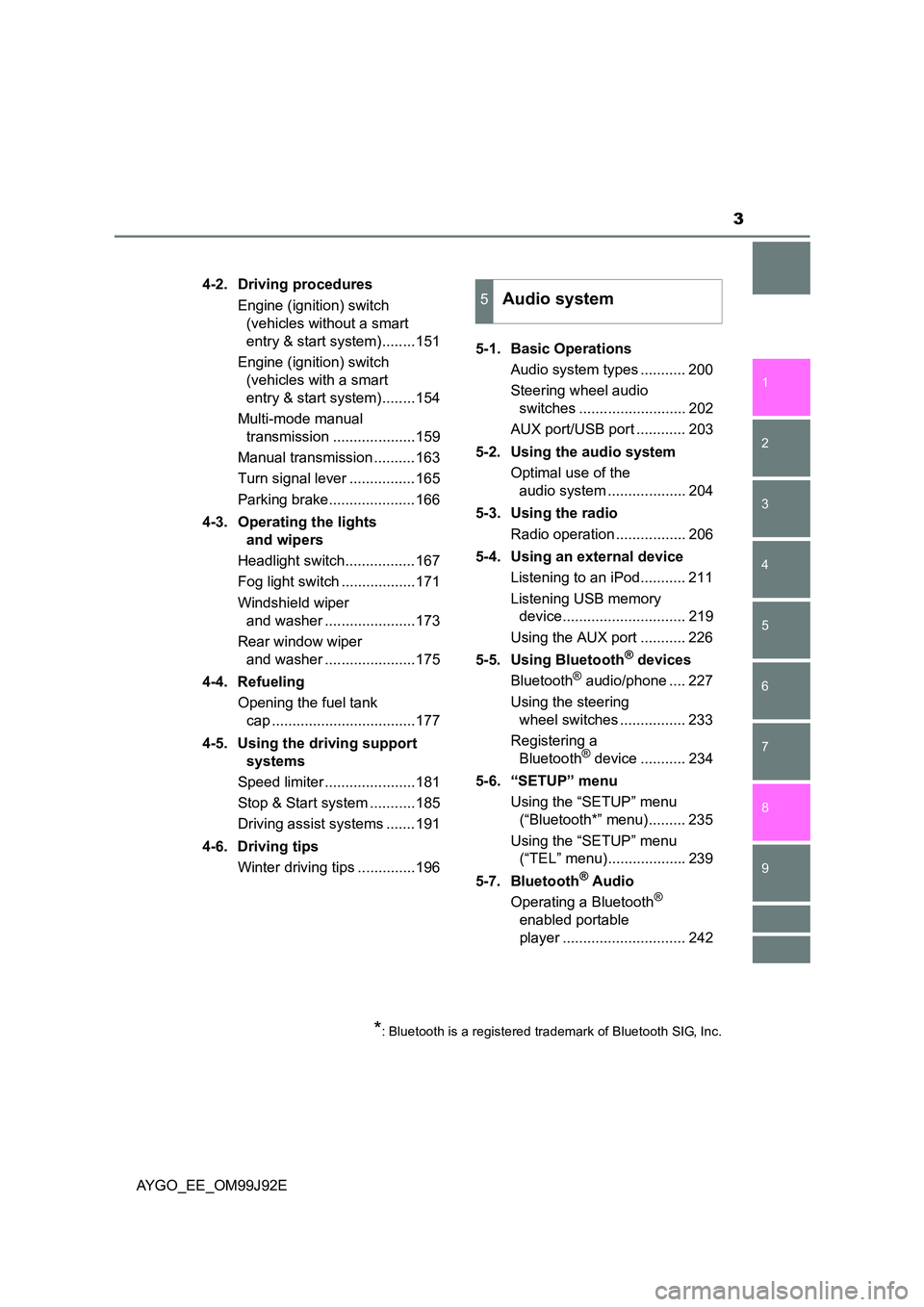
3
1
7
8
6
5
4
3
2
9
AYGO_EE_OM99J92E
4-2. Driving procedures
Engine (ignition) switch
(vehicles without a smart
entry & start system)........151
Engine (ignition) switch
(vehicles with a smart
entry & start system)........154
Multi-mode manual
transmission ....................159
Manual transmission ..........163
Turn signal lever ................165
Parking brake.....................166
4-3. Operating the lights
and wipers
Headlight switch.................167
Fog light switch ..................171
Windshield wiper
and washer ......................173
Rear window wiper
and washer ......................175
4-4. Refueling
Opening the fuel tank
cap ...................................177
4-5. Using the driving support
systems
Speed limiter ......................181
Stop & Start system ...........185
Driving assist systems .......191
4-6. Driving tips
Winter driving tips ..............196
5-1. Basic Operations
Audio system types ........... 200
Steering wheel audio
switches .......................... 202
AUX port/USB port ............ 203
5-2. Using the audio system
Optimal use of the
audio system ................... 204
5-3. Using the radio
Radio operation ................. 206
5-4. Using an external device
Listening to an iPod........... 211
Listening USB memory
device.............................. 219
Using the AUX port ........... 226
5-5. Using Bluetooth® devices
Bluetooth® audio/phone .... 227
Using the steering
wheel switches ................ 233
Registering a
Bluetooth® device ........... 234
5-6. “SETUP” menu
Using the “SETUP” menu
(“Bluetooth*” menu)......... 235
Using the “SETUP” menu
(“TEL” menu)................... 239
5-7. Bluetooth® Audio
Operating a Bluetooth®
enabled portable
player .............................. 242
5Audio system
*: Bluetooth is a registered trademark of Bluetooth SIG, Inc.
Page 40 of 440

401-1. For safe use
AYGO_EE_OM99J92E
WARNING
■ SRS airbag precautions
● Do not touch any of the component parts immediately after the SRS air-
bags have deployed (inflated) as they may be hot.
● If breathing becomes difficult after the SRS airbags have deployed, open a
door or window to allow fresh air in, or leave the vehicle if it is safe to do
so. Wash off any residue as soon as possible to prevent skin irritation.
● If the areas where the SRS airbags are stored, such as the steering wheel
pad, and front and rear pillar garnishes (vehicles with SRS curtain shield
airbags), are damaged or cracked, have them replaced by any authorized
Toyota dealer or repairer, or another duly qualified and equipped profes-
sional.
■ Modification and disposal of SRS airbag system components
Do not dispose of your vehicle or perform any of the following modifications
without consulting any authorized Toyota dealer or repairer, or another duly
qualified and equipped professional. The SRS airbags may malfunction or
deploy (inflate) accidentally, causing death or serious injury.
● Installation, removal, disassembly and repair of the SRS airbags
● Repairs, modifications, removal or replacement of the steering wheel,
instrument panel, dashboard, seats or seat upholstery, front, side and rear
pillars or roof side rails
● Repairs or modifications of the front fender, front bumper or side of the
occupant compartment
● Installation of a grille guard (bull bars, kangaroo bar, etc.), snow plows or
winches
● Modifications to the vehicle’s suspension system
● Installation of electronic devices such as mobile two-way radios (RF-trans-
mitter) and CD players
Page 94 of 440
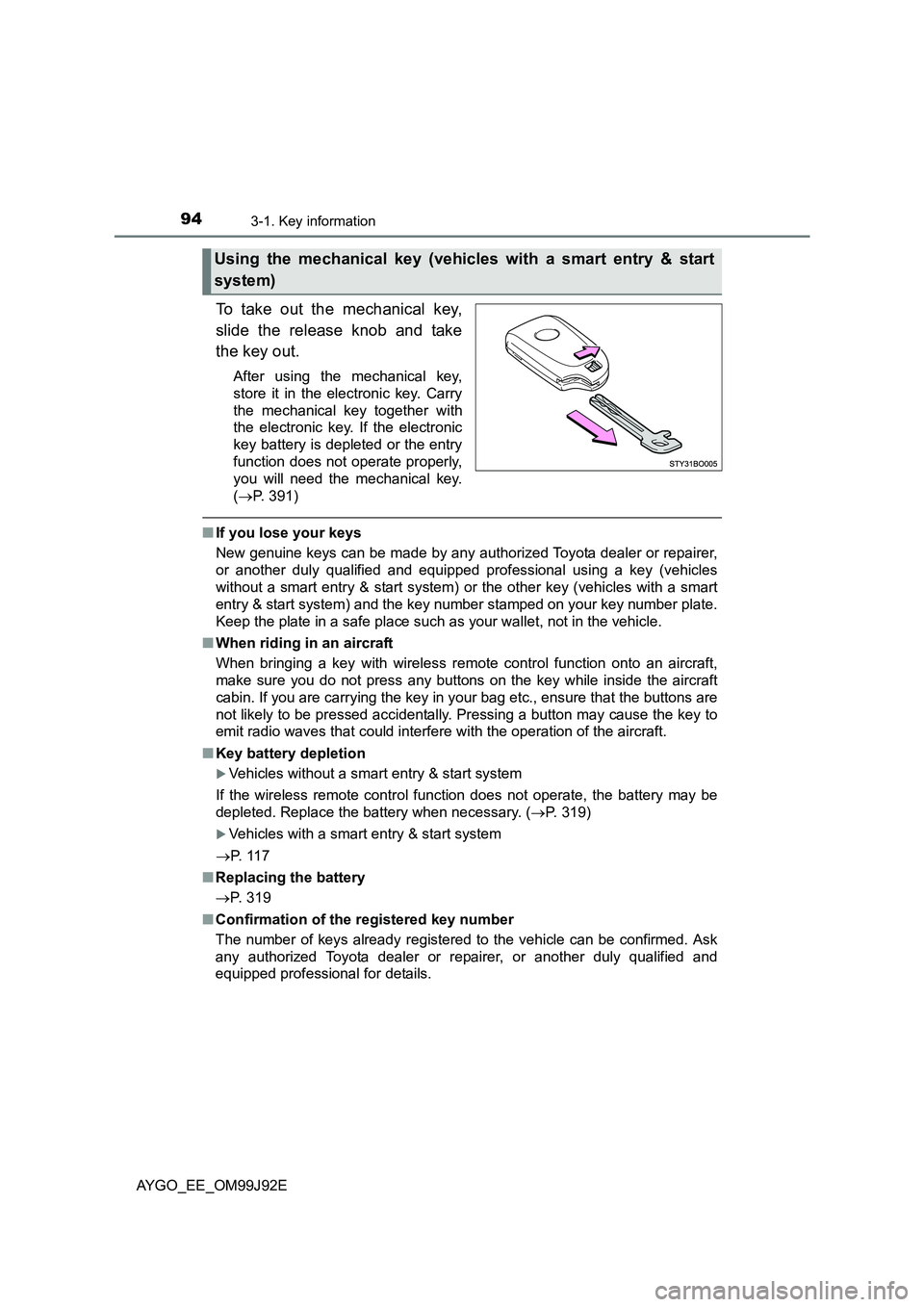
943-1. Key information
AYGO_EE_OM99J92E
To take out the mechanical key,
slide the release knob and take
the key out.
After using the mechanical key,
store it in the electronic key. Carry
the mechanical key together with
the electronic key. If the electronic
key battery is depleted or the entry
function does not operate properly,
you will need the mechanical key.
( →P. 391)
■If you lose your keys
New genuine keys can be made by any authorized Toyota dealer or repairer,
or another duly qualified and equipped pr ofessional using a key (vehicles
without a smart entry & start system) or the other key (vehicles with a smart
entry & start system) and the key number stamped on your key number plate.
Keep the plate in a safe place such as your wallet, not in the vehicle.
■ When riding in an aircraft
When bringing a key with wireless remo te control function onto an aircraft,
make sure you do not press any buttons on the key while inside the aircraft
cabin. If you are carrying the key in your bag etc., ensure that the buttons are
not likely to be pressed accidentally. Pressing a button may cause the key to
emit radio waves that could interfere with the operation of the aircraft.
■ Key battery depletion
�XVehicles without a smart entry & start system
If the wireless remote control function does not operate, the battery may be
depleted. Replace the battery when necessary. ( →P. 319)
�XVehicles with a smart entry & start system
→ P. 11 7
■ Replacing the battery
→ P. 319
■ Confirmation of the registered key number
The number of keys already registered to the vehicle can be confirmed. Ask
any authorized Toyota dealer or re pairer, or another duly qualified and
equipped professional for details.
Using the mechanical key (vehicles with a smart entry & start
system)
Page 101 of 440

1013-1. Key information
3
Operation of each component
AYGO_EE_OM99J92E
NOTICE
■ To prevent key damage
● Do not drop the keys, subject them to strong shocks or bend them.
● Do not expose the keys to high temperatures for long periods of time.
● Do not get the keys wet or wash them in an ultrasonic washer, etc.
● Do not attach metallic or magnetic materials to the keys or place the keys
close to such materials.
● Do not disassemble the keys.
● Do not attach a sticker or anything else to the surface of the electronic key.
● Do not place the keys near objects that produce magnetic fields, such as
TVs, audio systems and induction cookers, or medical electrical equip-
ment, such as low-frequency therapy equipment.
■ Carrying the electronic key on your person (vehicles with a smart entry
& start system)
Carry the electronic key 10 cm (3.9 in.) or more away from electric appli-
ances that are turned on. Radio wave s emitted from electric appliances
within 10 cm (3.9 in.) of the electronic key may interfere with the key, caus-
ing the key to not function properly.
■ In case of a smart entry & start system malfunction or other key-related
problems (vehicles with a smart entry & start system)
Take your vehicle with all the electronic keys provided with your vehicle to
any authorized Toyota dealer or repairer, or another duly qualified and
equipped professional.
■ When an electronic key is lost (vehicles with a smart entry & start sys-
tem)
If the electronic key remains lost, the risk of vehicle theft increases signifi-
cantly. Visit any authorized Toyota dealer or repairer, or another duly quali-
fied and equipped professional immediately with all remaining electronic
keys that was provided with your vehicle.
Page 105 of 440
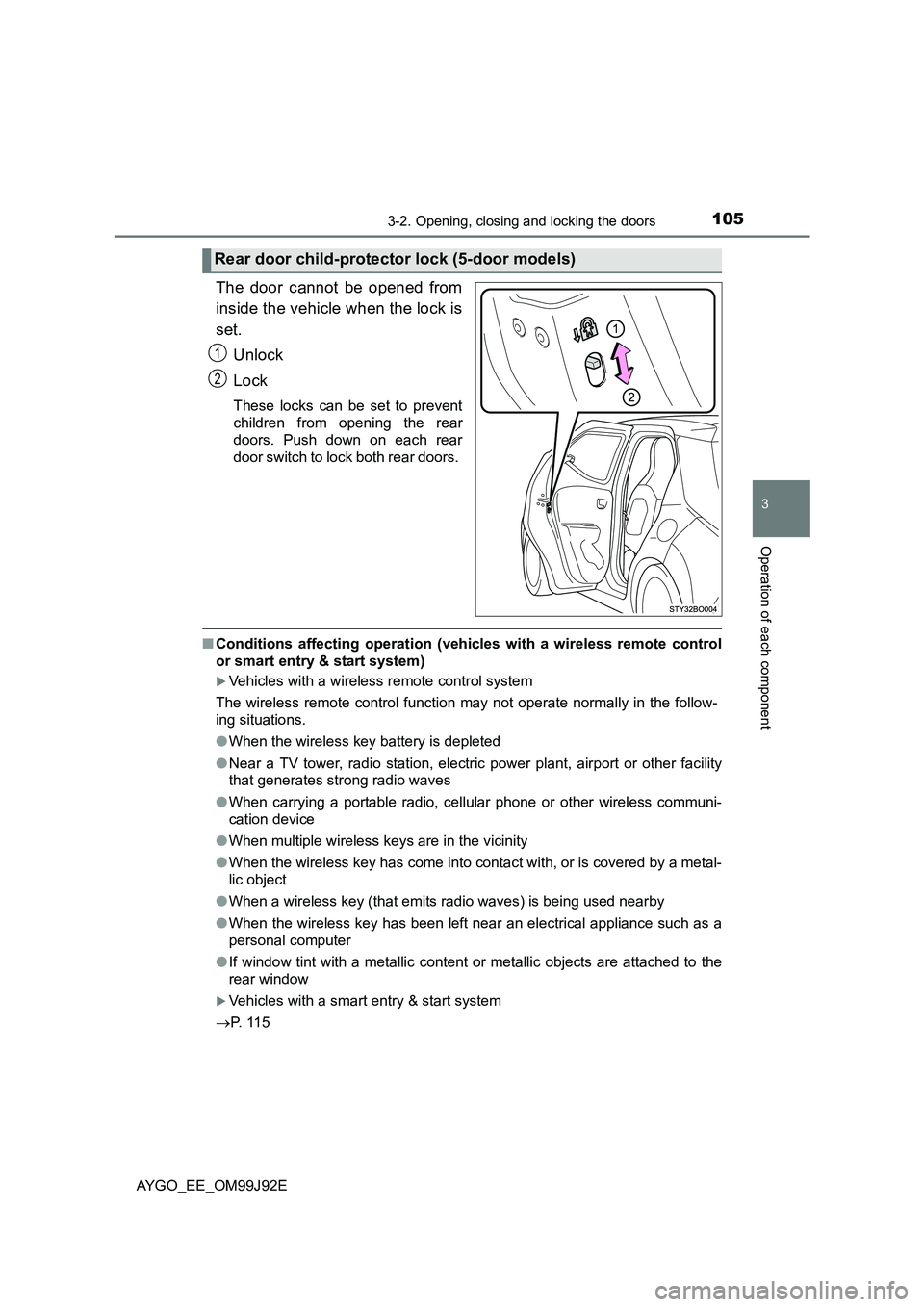
1053-2. Opening, closing and locking the doors
3
Operation of each component
AYGO_EE_OM99J92E
The door cannot be opened from
inside the vehicle when the lock is
set.
Unlock
Lock
These locks can be set to prevent
children from opening the rear
doors. Push down on each rear
door switch to lock both rear doors.
■ Conditions affecting operation (vehicles with a wireless remote control
or smart entry & start system)
�XVehicles with a wireless remote control system
The wireless remote control function may not operate normally in the follow-
ing situations.
● When the wireless key battery is depleted
● Near a TV tower, radio station, electric power plant, airport or other facility
that generates strong radio waves
● When carrying a portable radio, cellular phone or other wireless communi-
cation device
● When multiple wireless keys are in the vicinity
● When the wireless key has come into contact with, or is covered by a metal-
lic object
● When a wireless key (that emits radio waves) is being used nearby
● When the wireless key has been left near an electrical appliance such as a
personal computer
● If window tint with a metallic content or metallic objects are attached to the
rear window
�XVehicles with a smart entry & start system
→ P. 11 5
Rear door child-protector lock (5-door models)
1
2
Page 115 of 440
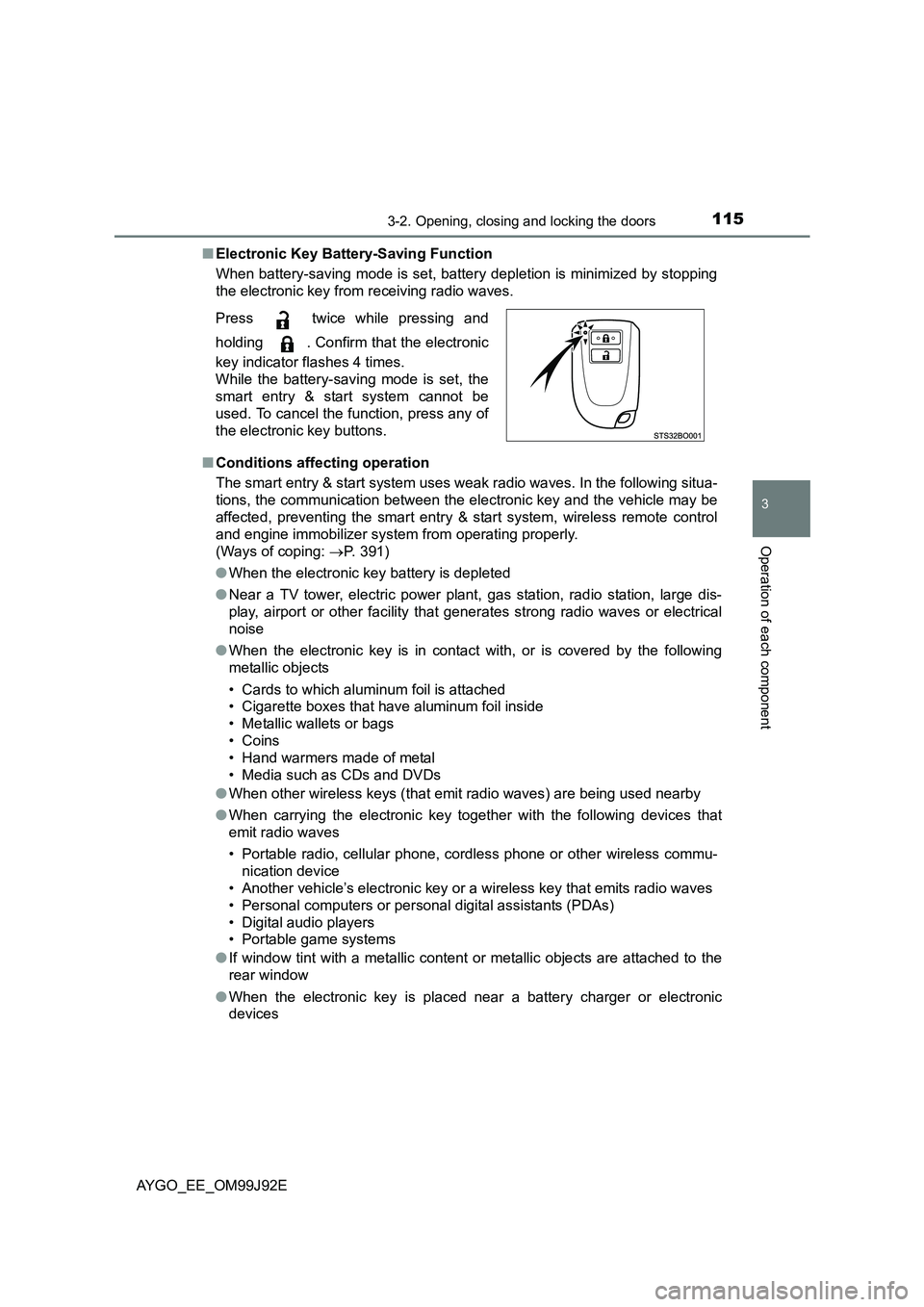
1153-2. Opening, closing and locking the doors
3
Operation of each component
AYGO_EE_OM99J92E
■ Electronic Key Battery-Saving Function
When battery-saving mode is set, battery depletion is minimized by stopping
the electronic key from receiving radio waves.
■ Conditions affecting operation
The smart entry & start system uses weak radio waves. In the following situa-
tions, the communication between the el ectronic key and the vehicle may be
affected, preventing the smart entry & start system, wireless remote control
and engine immobilizer system from operating properly.
(Ways of coping: →P. 391)
● When the electronic key battery is depleted
● Near a TV tower, electric power plant, gas station, radio station, large dis-
play, airport or other facility that generates strong radio waves or electrical
noise
● When the electronic key is in contact with, or is covered by the following
metallic objects
• Cards to which aluminum foil is attached
• Cigarette boxes that have aluminum foil inside
• Metallic wallets or bags
• Coins
• Hand warmers made of metal
• Media such as CDs and DVDs
● When other wireless keys (that emit radio waves) are being used nearby
● When carrying the electronic key together with the following devices that
emit radio waves
• Portable radio, cellular phone, cordless phone or other wireless commu-
nication device
• Another vehicle’s electronic key or a wireless key that emits radio waves
• Personal computers or personal digital assistants (PDAs)
• Digital audio players
• Portable game systems
● If window tint with a metallic content or metallic objects are attached to the
rear window
● When the electronic key is placed near a battery charger or electronic
devices
Press twice while pressing and
holding . Confirm that the electronic
key indicator flashes 4 times.
While the battery-saving mode is set, the
smart entry & start system cannot be
used. To cancel the function, press any of
the electronic key buttons.
Page 117 of 440

1173-2. Opening, closing and locking the doors
3
Operation of each component
AYGO_EE_OM99J92E
■ Electronic key battery depletion
● The standard battery life is 1 to 2 years.
● If the battery becomes low, an alarm will sound in the cabin when the engine
stops. ( →P. 359)
● As the electronic key always receives radio waves, the battery will become
depleted even if the electronic key is not used. The following symptoms indi-
cate that the electronic key battery may be depleted. Replace the battery
when necessary. ( →P. 319)
• The smart entry & start system or the wireless remote control does not
operate.
• The detection area becomes smaller.
• The LED indicator on the key surface does not turn on.
● To avoid serious deterioration, do not leave the electronic key within 1 m (3
ft.) of the following electrical appl iances that produce a magnetic field:
•TVs
• Personal computers
• Cellular phones, cordless phones and battery chargers
• Recharging cellular phones or cordless phones
• Table lamps
• Induction cookers
■ Customization that can be configured at any authorized Toyota dealer or
repairer, or another duly quali fied and equipped professional
Settings (e. g. smart entry & start system) can be changed.
(Customizable features: →P. 421)
■ If the smart entry & start system has been deactivated in a customized
setting
● Locking and unlocking the doors:
Use the wireless remote control or mechanical key. ( →P. 93, 391)
● Starting the engine and changing engine switch modes: →P. 392
● Stopping the engine: →P. 155
Page 122 of 440

1223-2. Opening, closing and locking the doors
AYGO_EE_OM99J92E
WARNING
■ Caution regarding interference with electronic devices
● People with implantable cardiac pacemakers, cardiac resynchronization
therapy-pacemakers or implantable cardioverter defibrillators should main-
tain a reasonable distance between themselves and the smart entry &
start system antennas. ( →P. 113)
The radio waves may affect the operation of such devices. If necessary,
the entry function can be disabled. Ask any authorized Toyota dealer or
repairer, or another duly qualified and equipped professional for details,
such as the frequency of radio waves and timing of the emitted radio
waves. Then, consult your doctor to see if you should disable the entry
function.
● Users of any electrical medical device other than implantable cardiac
pacemakers, cardiac resynchronization therapy-pacemakers or implant-
able cardioverter defibrillators should consult the manufacturer of the
device for information about its operation under the influence of radio
waves.
Radio waves could have unexpected effects on the operation of such
medical devices.
Ask any authorized Toyota dealer or repairer, or another duly qualified and
equipped professional for details on disabling the entry function.
Page 199 of 440
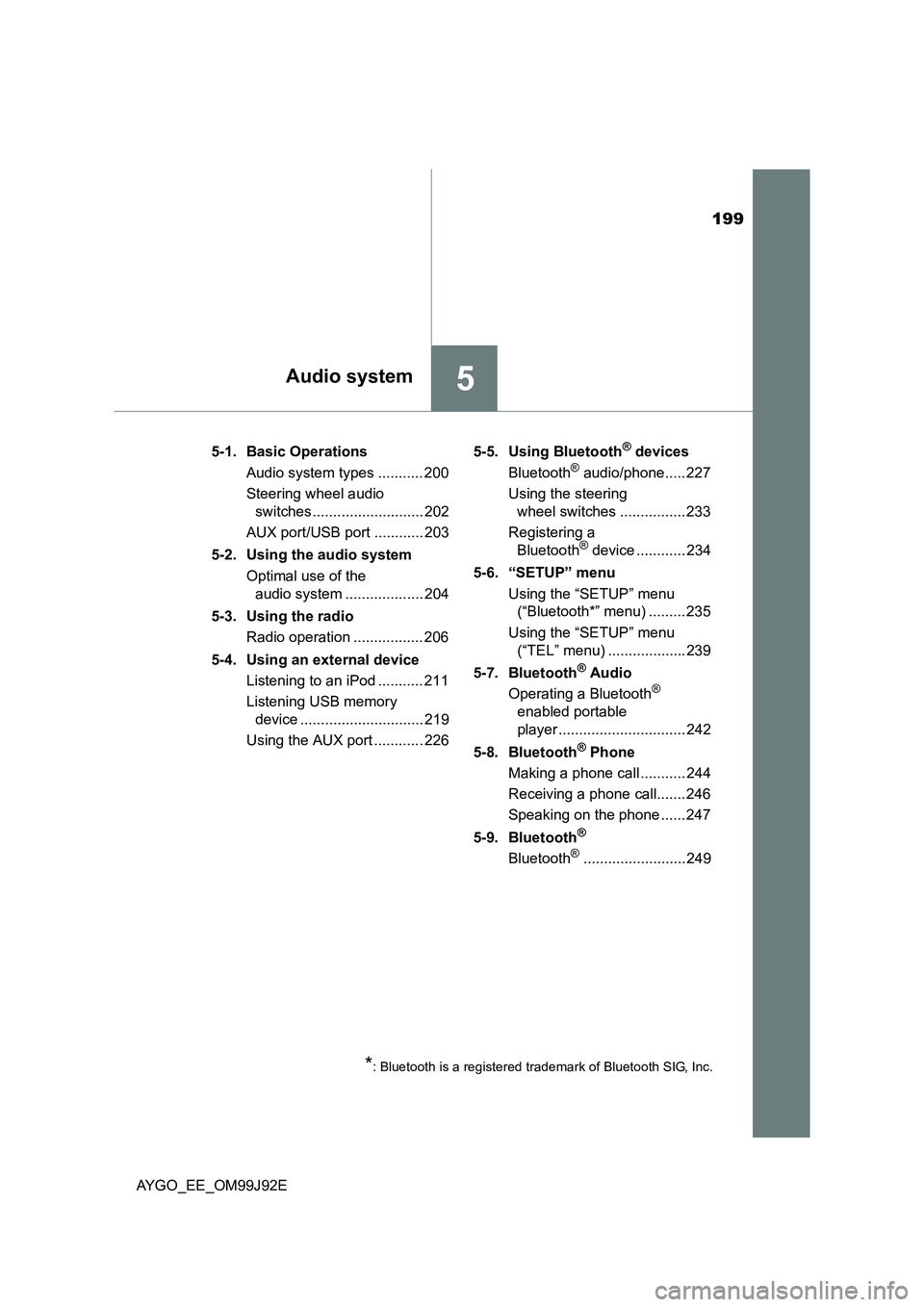
199
5Audio system
AYGO_EE_OM99J92E
5-1. Basic Operations
Audio system types ........... 200
Steering wheel audio
switches ........................... 202
AUX port/USB port ............ 203
5-2. Using the audio system
Optimal use of the
audio system ................... 204
5-3. Using the radio
Radio operation ................. 206
5-4. Using an external device
Listening to an iPod ........... 211
Listening USB memory
device .............................. 219
Using the AUX port ............ 226
5-5. Using Bluetooth® devices
Bluetooth® audio/phone..... 227
Using the steering
wheel switches ................ 233
Registering a
Bluetooth® device ............ 234
5-6. “SETUP” menu
Using the “SETUP” menu
(“Bluetooth*” menu) ......... 235
Using the “SETUP” menu
(“TEL” menu) ................... 239
5-7. Bluetooth® Audio
Operating a Bluetooth®
enabled portable
player ............................... 242
5-8. Bluetooth® Phone
Making a phone call ........... 244
Receiving a phone call....... 246
Speaking on the phone ...... 247
5-9. Bluetooth®
Bluetooth®......................... 249
*: Bluetooth is a registered trademark of Bluetooth SIG, Inc.
Page 200 of 440
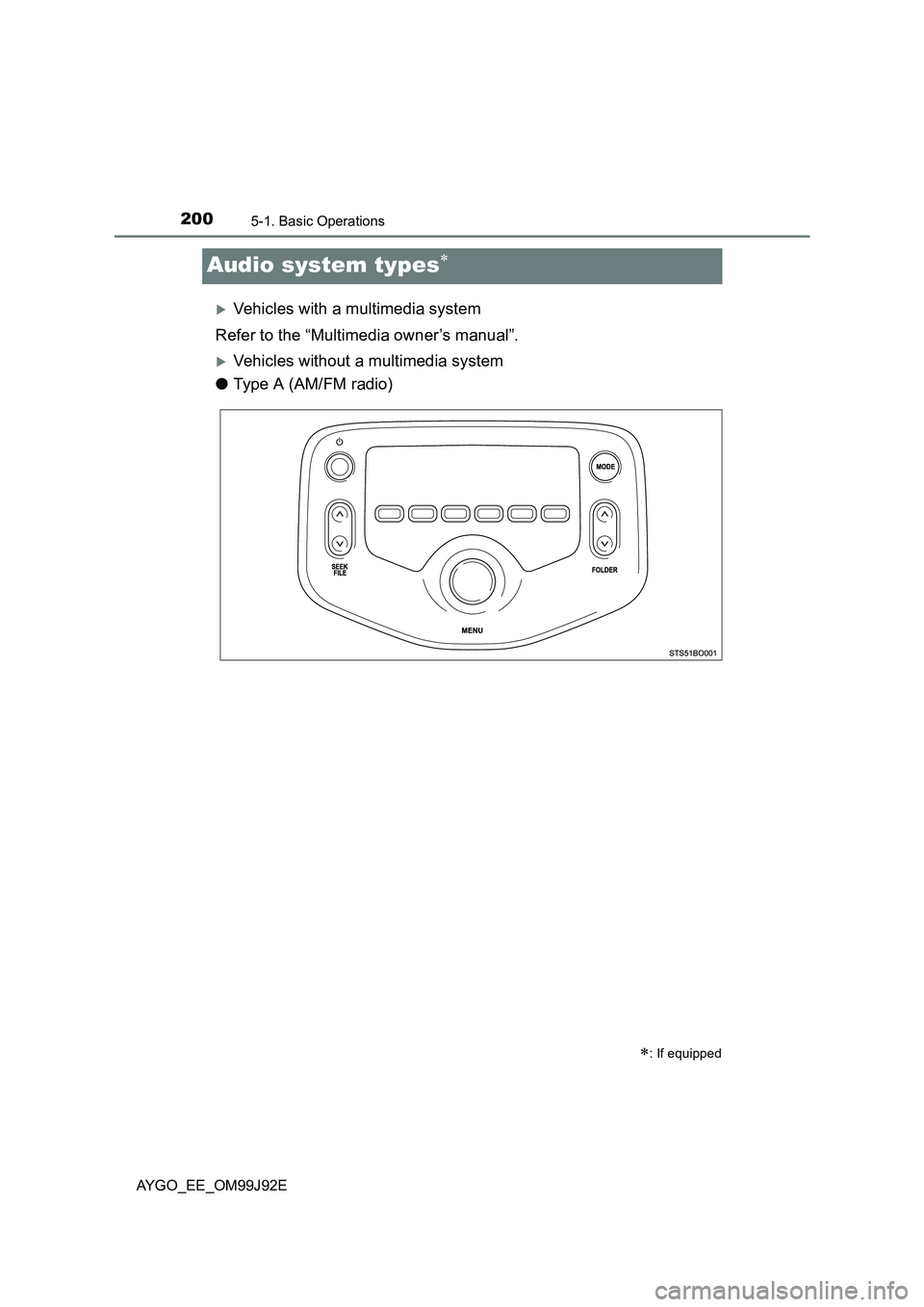
2005-1. Basic Operations
AYGO_EE_OM99J92E
Audio system types∗
�XVehicles with a multimedia system
Refer to the “Multimedia owner’s manual”.
�XVehicles without a multimedia system
● Type A (AM/FM radio)
∗: If equipped